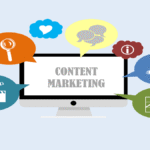Being present where your consumers are is the foundation of inbound marketing. By meeting their demands with inbound marketing services like marketing automation, email marketing, advertisements, SEO, and content. However, to do all of that, you must use some of the best inbound marketing tools, which may help your inbound marketing plan be successful.
What are marketing platforms, then? To put it simply, they are straightforward, all-purpose software that lets you run your marketing operations and promote your goods and services via the inbound marketing channels of your choice. To assist you in progressing down your inbound funnel—that is, increasing traffic, prospects, and customers—it combines one or more inbound marketing techniques.
Popular Inbound Marketing Tools

1. HubSpot
HubSpot has almost become synonymous with CRM marketing. It seems as if their platform was created by marketers for marketers. HubSpot’s comprehensive approach to inbound marketing tools is one of its main advantages.
Personalized email marketing, blogging and social media account management, paid advertising, landing page creation and A/B testing, and automated targeted communications throughout the customer journey are all available to users.
All of this is seamlessly connected, so when a warm lead completes a certain task, your sales team is promptly alerted to the lead’s data. It’s easy to monitor your performance and determine what is generating the most conversions. You’ll question how you managed without this kind of inbound marketing tool.
Features:
- Predictive Analytics.
- Real-time Consumer-facing Chat.
- Relationship Tracking.
- For Mac Devices.
- Sales Reports.
- Scheduling.
- Collaboration Tools.
- Source Tracking.
- Task Scheduling.
- Activity Tracking and many more.
Price:
- Free plan available.
- Starter: $20/user/month.
2. Zoho
One of the best inbound marketing tools and a top choice for targeted email list management is Zoho. There is a rather high learning curve, according to some customers, but if you master the amazing workflow automation capabilities, you should soon recover any lost training time. To help you get started, Zoho’s website offers a wealth of tools and several customer service alternatives.
To assist inbound marketers in attracting and nurturing prospects, Zoho provides several services. When clients engage with their company, users get real-time alerts so that you may respond immediately. In addition, users may program automatic answers to common questions and learn when it’s ideal to reach clients via social media, phone, email, and live chat.
Features:
- eCommerce Management.
- Customer Support.
- Customer Segmentation.
- Search Marketing.
- Campaign Analytics.
- Scheduling.
- Sales Reports.
- Sales Approval.
- Channel Management.
- Marketing Calendar and many more.
Price: Starting from $14/user/month. Contact Zoho for details.
3. ContentKing
The only SEO auditing tool that claims to be able to track and report on your websites around the clock is ContentKing. This feature is perfect for assisting you in promptly identifying and fixing problems before they impact website performance or cost you a precious consumer.
Google Search Console, Google Analytics, and Slack are just a few of the systems that ContentKing interfaces with. Slack is particularly useful for discussing problems with your internal development team.
Moreover, the software can keep track of any modification you make to your website, assisting you in linking any shifts in ranking to specific actions. ContentKing is user-friendly and provides a variety of options to fit various budgets. Before investing, you may use the company’s free trial to make sure it’s the correct choice for you.
Features:
- Website Management.
- Uptime Reporting.
- Real-Time Reporting.
- Issue Tracking.
- Issue Management.
- For Websites.
- Data Visualization.
- Data Import/Export.
- Audit Management.
- Bug/Issue Capture and many more.
Price: Starting from $139/feature/month.
4. ActiveCampaign
B2B businesses may interact with both current and future clients by using ActiveCampaign, a platform for customer experience automation. Email marketing, forms, landing pages, marketing automation, bespoke events, and more are all included in its Plus bundle.
The Professional package goes one step further by providing split automation, site messages, attribution reporting, and predictive sending capabilities driven by AI. Furthermore, there is an Enterprise package that has capabilities that well-known B2B organizations may need, such as custom objects, SLAs, and single sign-on.
Similar to HubSpot, its platform comes with a free CRM by default; however, to have similar CRM features, you will need to buy a bundle of ActiveCampaign’s Marketing Automation + Enhanced CRM. To provide a smooth user experience, ActiveCampaign’s CRM is natively connected to its marketing automation software.
Features:
- Real-Time Notifications.
- Client Management.
- Inbox Management.
- Email Templates.
- Email Tracking.
- Tagging.
- Sales Activity Management.
- For Startups.
- Channel Management.
- Customer Database and many more.
Price:
- Starter: $15/month.
- Plus: $49/month.
- Pro: $79/month.
- Enterprise: $145/month.
5. Sprout Social
At the time of writing, Sprout Social has over 30,000 companies under its management, solidifying its reputation as one of the most approachable inbound marketing tools for marketing. Sprout provides a variety of tools for scheduling, reporting, managing conversations, and measuring social media activity.
In addition to its marketing features, Sprout can automate responses and install ChatBots in a matter of minutes, making it very convenient for your customer support staff.
Features:
- Social Media Monitoring.
- Social Media Integration.
- Negative Feedback Management.
- Dashboard.
- Data Visualization.
- Editorial Calendar.
- Performance Metrics.
- Response Management.
- Task Management.
- Competitive Analysis and many more.
Price:
- Standard: $249/user/month.
- Professional: $399/user/month.
- Advanced: $499/user/month.
6. Foleon
Foleon was created to enable content producers of all abilities to produce polished, interactive, media-rich content on any device, from any location. The marketing customization tools are unmatched, and the drag-and-drop editors and intuitive interfaces make both creating and editing a snap. When teamwork is easy and enjoyable, the finest material is produced.
It is simple for internal and external stakeholders to collaborate, provide comments, and update and approve projects. All the while making sure the brand is safeguarded and the project owner maintains control over the assets. It goes without saying that the platform is very safe and offers a wealth of information to assist you in enhancing user experience and boosting speed.
Features:
- Categorization/Grouping.
- Activity Dashboard.
- Activity Tracking.
- Content Library.
- Content Management.
- Conversion Tracking.
- Customizable Branding.
- Data Import/Export.
- Drag & Drop.
- Engagement Tracking and many more.
Price: Contact sales.
7. Grammarly
Grammarly is one of the best inbound marketing tools for spelling and grammatical checks, in our humble view. We just couldn’t function without it. Grammarly provides busy content writers with a variety of tools to help them in producing higher-quality material for the market, in addition to its useful QA features.
Writers are warned about problems with spelling, grammar, and readability by an AI-powered writing assistant. It even alerts you when your writing style isn’t the most appropriate for the intended audience and when you should reword phrases to be more succinct, easier to read, or use a more active voice.
You may add your lexicon to Grammarly to make sure it works as efficiently as possible and to save you time. Intentional or inadvertent plagiarism will also be checked, ensuring that the information on your website is always unique. It is one of the best inbound marketing tools.
Features:
- Content Generation.
- Content Creation.
- Text Summarization.
- Content Management.
- Template Management.
- Focus Aid.
- Multiple User Accounts.
- Personalization and Recommendation.
- Real-Time Analytics.
- Real-Time Monitoring and many more.
Price:
- Free plan available.
- Pro: $12/user/month.
8. Canva
On any device, from any location, Canva assists time-pressed marketers in producing top-notch visuals for presentations, social media, videos, posters, logos, and much more. Users may choose from hundreds of templates to produce photos that fit their brand and target demographic.
Canva has many collaboration tools, including the ability to share design versions, solicit approvals, and provide feedback, in recognition of the fact that design processes often include several stakeholders.
Sharing and storing color schemes and logos inside the editing interface is another way to guarantee brand consistency. A range of options are available, including a free one for individuals and small groups.
Features:
- CMS Integration.
- Pre-built Templates.
- Content Management.
- Template Management.
- Templates.
- Asset Library.
- Media Library.
- Text Editing.
- Search/Filter.
- Real-Time Editing and many more.
Price:
- Free version available.
- Pro: $15/user/month.
- Team: $10/user/month.
9. Google Analytics
The most popular marketing analytics tool is Google Analytics. It allows you to measure almost anything under the digital sun, is free, and is easy to set up and use. Also, regardless of your background in marketing, the resource center and Google Analytics Academy training and assistance are quite helpful.
Although they may be more difficult to understand and set up, certain of Google Analytics’ capabilities may be worth the additional work. One such example is Google Tag Manager (GTM). You may monitor web page activity, including scroll depth, clicks, downloads, and video activity, by including short bits of custom or templated code on your website.
If you’re exploring ways to boost your brand visibility, you can also check out other marketing tools designed to help you streamline campaigns, track performance, and reach your audience more effectively. It’s the perfect complement to your current strategy. That’s one of the best inbound marketing tools.
Features:
- Pageview Tracking.
- Augmented Analytics.
- Intelligent Search.
- Customizable Reports.
- Usage Tracking/Analytics.
- Reporting & Statistics.
- Campaign Tracking.
- Website Analytics.
- Real-Time Data.
- Data Aggregation and many more.
Price: Free.
Things To Consider When Choosing Inbound Marketing Tools
Cost: You will always want to get a solid return on your investment in inbound marketing tools. Although CMSs aren’t prohibitively costly, you should make sure yours can meet your needs since they are a continuous expense. Thankfully, the majority of CMS suppliers give a range of plans that can be tailored to your company’s needs as it develops.
Usability: With WYSIWYG editors, the finest CMS is very simple to use, making it simple to modify and update pages. At some point, you may wish to add your code (for instance, in the case of the Google Tag Manager described above). Therefore, choosing a tool that enables this is unquestionably a smart choice.
Which other businesses use them: Finding out who else uses a product is one of the best methods to determine if it will work for your company. If you are an e-commerce merchant, for instance, you should look at other companies in your industry that have been using the CMS effectively for a long period. On the websites of the companies, you will likely discover case studies and testimonials.
High security levels: It should go without saying that protecting your company and front-end users is essential. It might take a lot of time and effort to update your CMS, and mistakes can happen. Listen to someone who has been there before! Ask your supplier to offer you a thorough rundown of how updates will operate, who is in charge of the SSL certificate, and how manual backups will operate throughout the consultation process.
Customer service: After the first few months, you may not need much handholding, but it’s still helpful to know it exists!
FAQ
Q: What is the main emphasis of inbound marketing?
A: By producing engaging experiences and helpful information, inbound marketing is a digital marketing strategy that helps you draw clients to your company. Instead of depending just on advertisements, it places a higher priority on information exchange and content production as a means of reaching consumers.
Q: To what extent does inbound marketing work?
A: One of the best strategies for increasing traffic, leads, and income for business-to-business (B2B) organizations is inbound marketing. Your company may boost brand awareness and draw in quality, devoted leads by offering tools and material that cater to your target customers.
Q: Does pull marketing apply to inbound marketing?
A: Instead, pull marketing—also referred to as inbound marketing—focuses on attracting your ideal client. Prioritizing relationship-building, pull marketing makes sure your leads are warm—that is, they already know and trust you—before making an offer.







